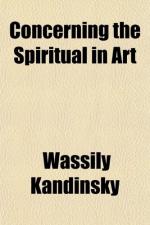Gauguin has greater solemnity and fire than Cezanne. His pictures are tragic or passionate poems. He also sacrifices conventional form to inner expression, but his art tends ever towards the spiritual, towards that profounder emphasis which cannot be expressed in natural objects nor in words. True his abandonment of representative methods did not lead him to an abandonment of natural terms of expression—that is to say human figures, trees and animals do appear in his pictures. But that he was much nearer a complete rejection of representation than was Cezanne is shown by the course followed by their respective disciples.
The generation immediately subsequent to Cezanne, Herbin, Vlaminck, Friesz, Marquet, etc., do little more than exaggerate Cezanne’s technique, until there appear the first signs of Cubism. These are seen very clearly in Herbin. Objects begin to be treated in flat planes. A round vase is represented by a series of planes set one into the other, which at a distance blend into a curve. This is the first stage.
The real plunge into Cubism was taken by Picasso, who, nurtured on Cezanne, carried to its perfectly logical conclusion the master’s structural treatment of nature. Representation disappears. Starting from a single natural object, Picasso and the Cubists produce lines and project angles till their canvases are covered with intricate and often very beautiful series of balanced lines and curves. They persist, however, in giving them picture titles which recall the natural object from which their minds first took flight.
With Gauguin the case is different. The generation of his disciples which followed him—I put it thus to distinguish them from his actual pupils at Pont Aven, Serusier and the rest— carried the tendency further. One hesitates to mention Derain, for his beginnings, full of vitality and promise, have given place to a dreary compromise with Cubism, without visible future, and above all without humour. But there is no better example of the development of synthetic symbolism than his first book of woodcuts.
[Footnote: L’Enchanteur pourrissant, par Guillaume Apollinaire, avec illustrations gravees sur bois par Andre Derain. Paris, Kahnweiler, 1910.]
Here is work which keeps the merest semblance of conventional form, which gives its effect by startling masses of black and white, by sudden curves, but more frequently by sudden angles.
[Footnote: The renaissance of the angle in art is an interesting feature of the new movement. Not since Egyptian times has it been used with such noble effect. There is a painting of Gauguin’s at Hagen, of a row of Tahitian women seated on a bench, that consists entirely of a telling design in Egyptian angles. Cubism is the result of this discovery of the angle, blended with the influence of Cezanne.]




